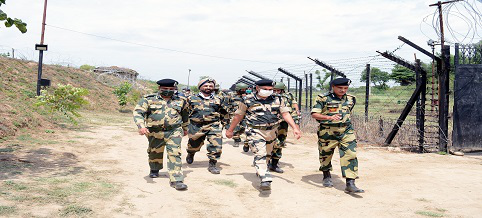Applying basic border security concepts

 Time to address basic issues pertaining to border guarding forces on doctrine, deployment, and domination
Time to address basic issues pertaining to border guarding forces on doctrine, deployment, and domination
The highly condemnable and provocative Chinese incursions and subsequent killing of twenty brave hearts have exposed the chinks and weaknesses in border security not only in Galwan but also all along international borders. Chinese have successfully claimed territory up to 1959 claim line in Galwan valley in Eastern Ladakh and have followed the famous dictum of Sun Tzu, the author of Art of War: “The supreme art of war is to subdue the enemy without fighting.”
“Building a wall would not solve our border security challenges“ argues Peter Paul Buttigieg, an American Afghanistan war veteran. Since India’s borders have always been disquiet, securing and ensuring territorial integrity of national borders and prevent enemy ingress into our territory has always been a challenge for border guarding forces in the face of hostile neighbours all around. Border guarding forces have ensured territorial integrity of national borders by keeping enemy at bay thus ensuring safety of borders. By their presence border guarding forces have been able to inculcate a sense of security amongst border population by winning their hearts and minds despite underdeveloped border areas, unemployment and poverty.
Border guarding forces are crying for attention to make border guarding an offensive defence concept, which is aggressive in design and offensive in conduct. It is only possible if leadership at higher levels is professional in border guarding as well as matters military to understand the criticalities of creating an environment and habitat, which has aggressiveness inbuilt in infrastructure, equipment and training. Does our environment and habitat cater for offensiveness? Answer sadly is no since neither an eco-system nor habitat is existing on ground. It has to be prepared, which will require capital expenditure, conceptual appreciation, planning and physical execution on ground. If this kind of environment exists, nation can demonstrate that enemy can be subdued without fighting.
Border security has two important aspects firstly, the physical security which is the task of border guarding forces through physical domination of borders and secondly security through détente whereby through diplomatic engagements an environment is created which complements the efforts of border guarding forces by negotiating ground level disputes and irritants and thus strengthening border security.
Border guarding forces and leadership at ground level are ensuring effective border security despite poor administrative as well operational infrastructure. The higher leadership and government need to take professional proactive steps to create an aggressive operational infrastructure to not found wanting when need arises. Border security flow from national security policy.
The national security policy in general calls for border guarding forces to ensue sanctity of international boundary by physical domination of international borders and take all actions, which are required to defeat anti-national elements. In consonance with this policy, Border Security Force, Indo Tibetan border police (ITBP), Shastra Seema Bal (SSB) and Assam Rifles have ensured and played their role in an excellent manner. However, border-guarding forces have not received the desired support from government and higher leadership in creating infrastructure, which injects aggressiveness in border security. Why since higher leadership and government lacks professional security consciousness. The other reason for lack of aggressiveness in border security is that professionals have no communication face with government to advise it on border security and matters military aspects.
The second dimension of border security is diplomatic engagements to settle border disputes and enhance peace and tranquility on borders. As of now, the situation with Nepal is tense due to diplomatic laid-back approach of government and the percolation of diplomatic tension was an incident on 12 June 2020 on Indo-Nepal border resulting in killing and tension between border guarding forces and has made border guarding difficult. Similar is the situation with Pakistan and China, which has made border guarding more challenging and difficult.
The present day state of border guarding infrastructure calls for immediate attention from government to improve infrastructure with offensiveness in design, better weapons and equipment, training which is most neglected part, filling of large scale vacancies existing in border guarding forces, bring in professionalism in higher leadership. Also better administrative amenities too need to be set up.
The old outdated SOPs need to be updated keeping ground level realities and adversary habits and conduct in view. There is another crying need to have professional at frontier and force headquarters. Border guarding forces need to have border security operational doctrine, which flows from national security policy, which unfortunately is non-existent. To make disquiet Indian borders quiet there is urgent need to upgrade border-guarding infrastructure. Hope government listens and introspects honestly.



Leave a Reply